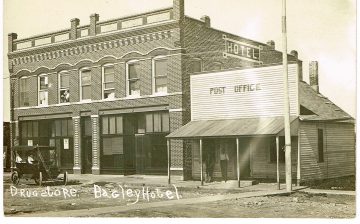
Bagley. Mary Bagley owned the land on which this village was built. In 1884, the Chicago, Burlington, and Quincy Railroad depot was erected. The St. Paul Land Company bought land from Mrs. Bagley and platted and named the village. William Thiessa bought the first lot and built a hotel, hauling the lumber over the river on the ice from Clayton, Iowa. On January 1, 1885, the building was open for business. This hotel has since been enlarged and is now known as the Burlington Hotel.
Beetown. In the early part of 1827, Cyrus Alexander found a nugget of lead weighing 425 pounds in the cavity made by the overturning of a large bee tree. The discovery was called the Bee Lead, and thus originated the name of the town.
Big Patch. At one time known as Kaysville, Big Patch was named by Welsh miners for a large area of sheet lead ore found in the vicinity. In their homeland, the Welsh often spoke of a patch of brush or a patch of timer, and so it came naturally to speak of a big patch of lead ore.
Bischoff Island. This is a government island, directly north of Sinipee. Mr. Casper Bischoff settled this island and named it for his father, an immigrant from Germany who was killed in the Civil War.
Blaine (Burnett County). This township, established in 1902, was probably named for John G. Blaine, the Progressive Republican at the 1902 convention. [John Blaine was from the Montfort-Preston area and was a Wisconsin and U.S. Senator]
Blake’s Prairie. Named for an early settler, Page Blake.
Bloomington. The village was first called Tafton, for a Mr. Taft who had built the first mill in 1841. By 1867 the villagers were on the outs with Mr. Taft—some financial trouble. About the same time, the Spencer Blacksmith Shop got the patent on a new device for sowing oats. This was a vigorous spur to agriculture, and local people expressed their elation in the name Blooming Town, soon converted to Bloomington. In 1867, by an act of the legislature, the name Bloomington was applied to both the township and the village.
Blue River. When the railroad first came through in 1856, the village was called Minnehaha, but soon afterward the name was changed to Blue River. The river was named for a Mr. Blue, who owned a farm through which the river ran, just east of the present village.
Boat Yard Hollow. Boat Yard Hollow is located halfway between East Dubuque, Illinois, and Eagle Point bridge. Flatboats were built on this site about 1848, and a ferryboat across the Mississippi River was established at Boat Yard Hollow in that year.
Boscobel. There are three possible sources for the name of Boscobel. Some say the name is a Castilian vulgarism for ‘beautiful wood.’ Others say it was named for the friendly little English wood that sheltered Charles Stuart after the luckless battle of Worcester. A third group says that an early settler had two cows, one Boss, one Bell. When he called them to come home at night, he would sing out: ‘Co Boss, co Bell!’
Bridgeport (Crawford County). The first half of the name of this township derives from the fact that a bridge here connects Crawford and Grant Counties. The second half of the name came from the old ferry crossing to the ‘ports’ of each county.
British Hollow. The men in the area always spent the evenings together at the general store or tavern. The question of a new name for the place arose. One man was mistakenly under the impression that the French still claimed the land. He said, ‘While the French still claim this place, it won’t be long before the British have it, and as we are mostly English here, let’s call it British Hollow.’
Brodtville. Named for Josh Brodt. A post office was established in 1864 and closed in 1883.
Buena Vista. This place near Potosi is Spanish for ‘beautiful view.’ A group of early settlers named it. [There are also Buena Vistas in Richland and Waukesha Counties.]
Burnett County. [Thomas Burnett was from Mt. Hope.] Named for Thomas P. Burnett, an early Wisconsin legislator. In 1829 he was appointed Indian Agent at Prairie du Chien and made his home there until 1837, when he moved to Cassville. He was, at the time of his death in 1846, a member of the Wisconsin Constitutional Convention.
Burton. The old mill constructed by Daniel R. Burt on Grant River was the nucleus about which a post office, store, and blacksmith shop were built.
